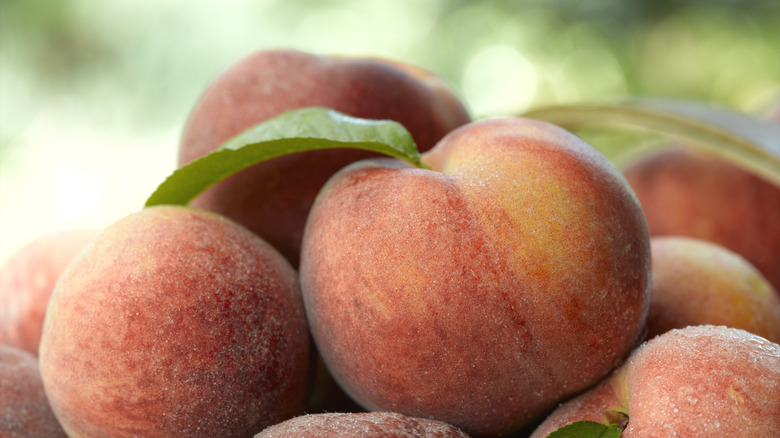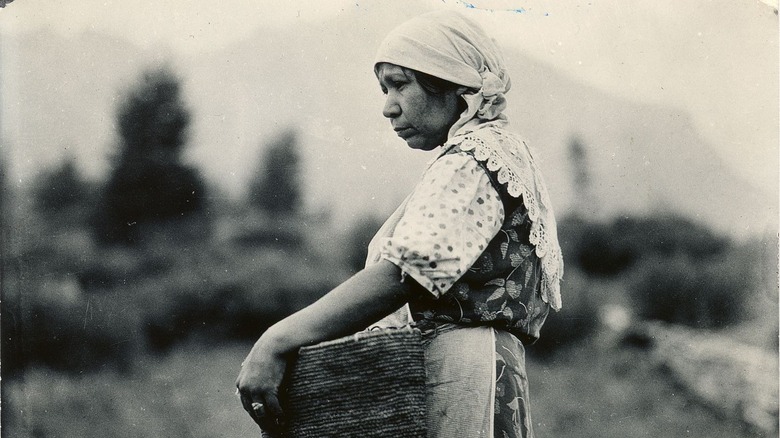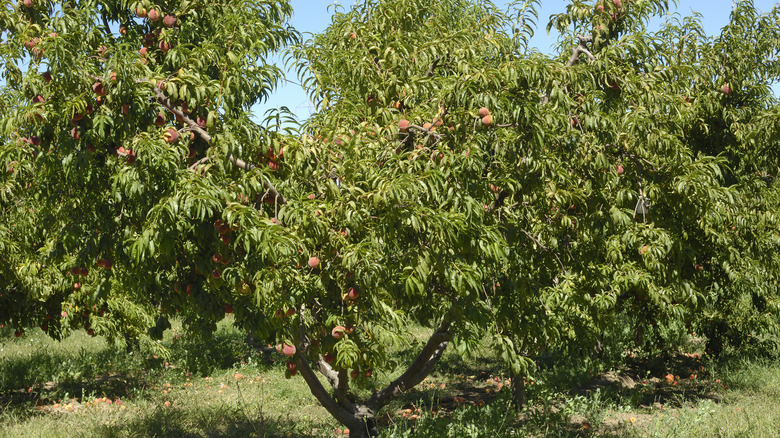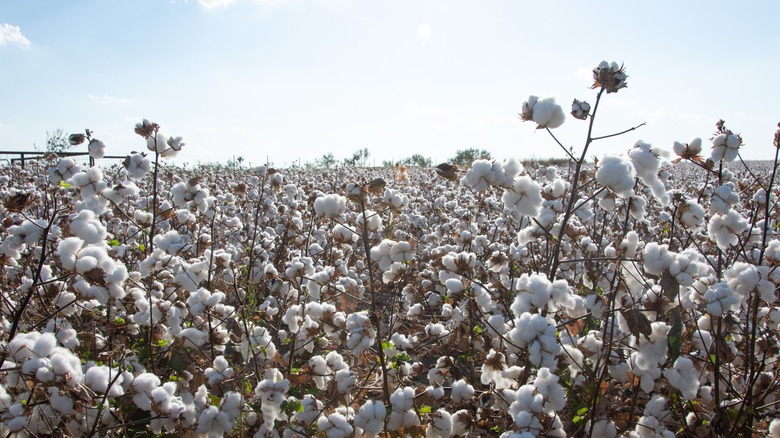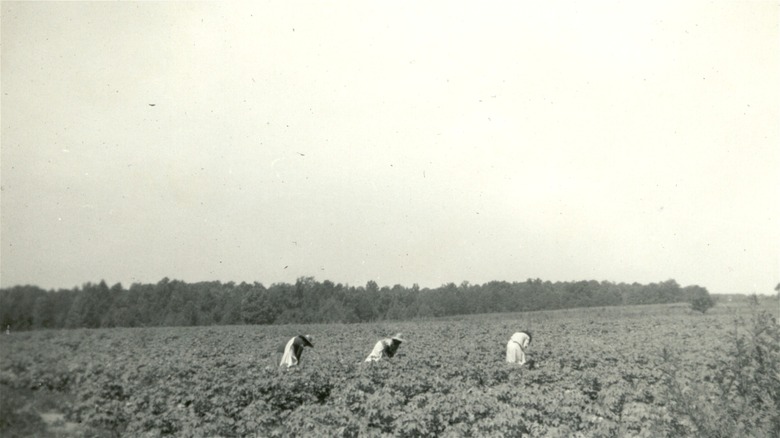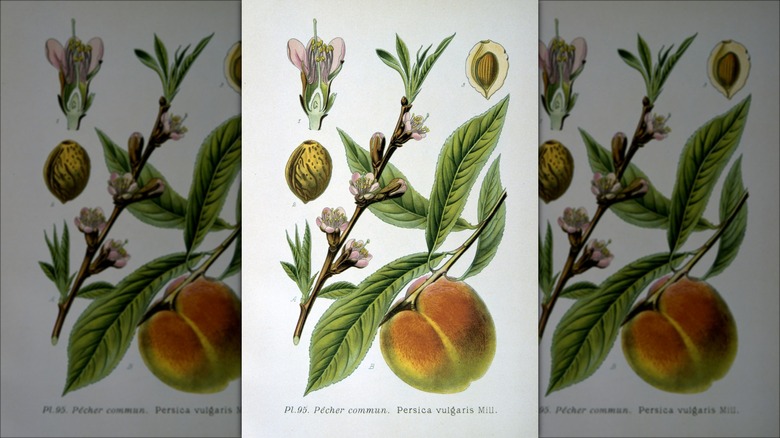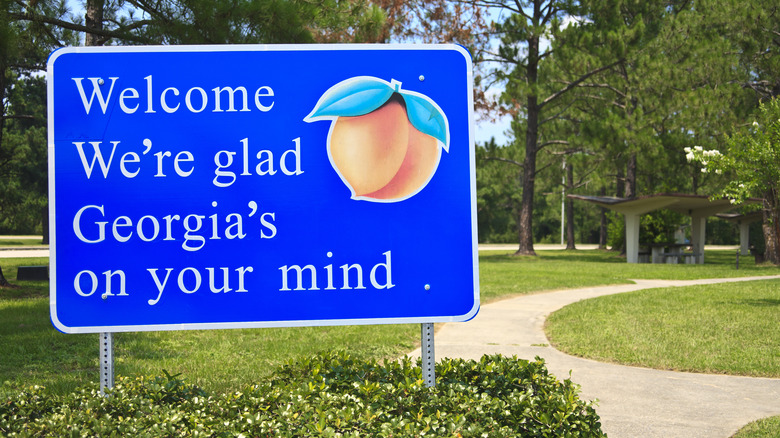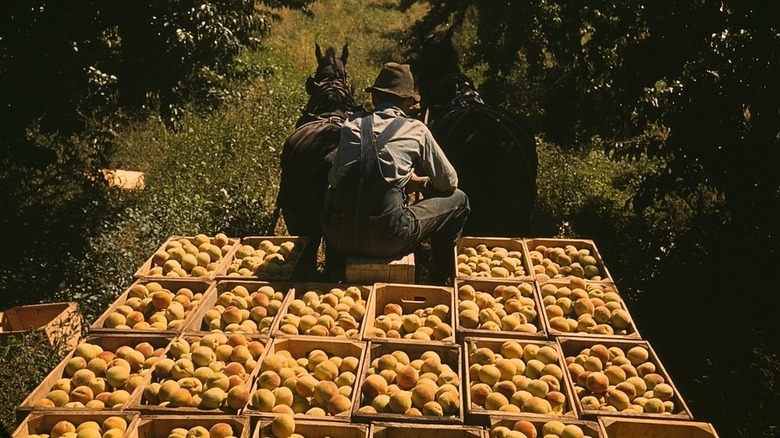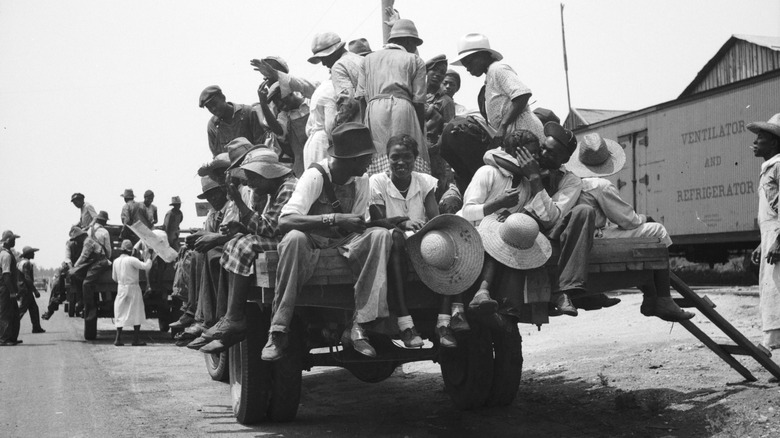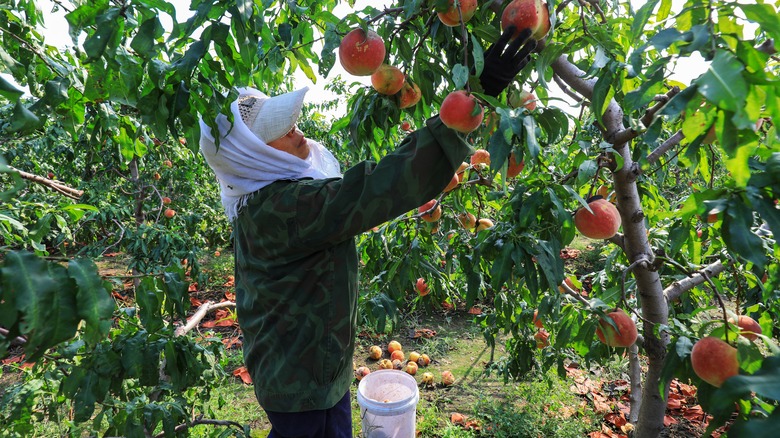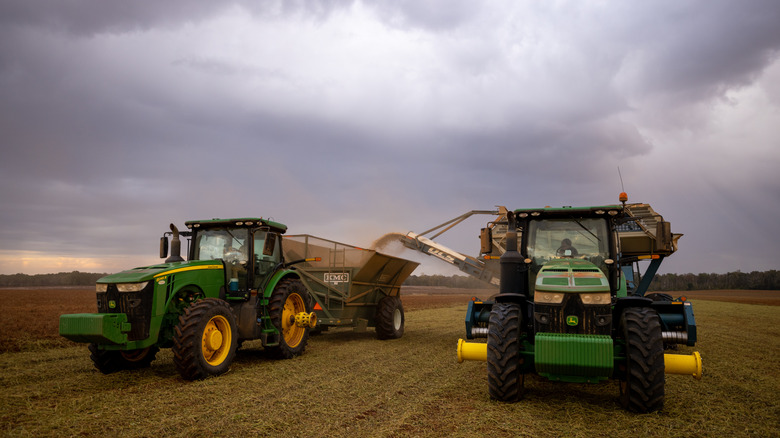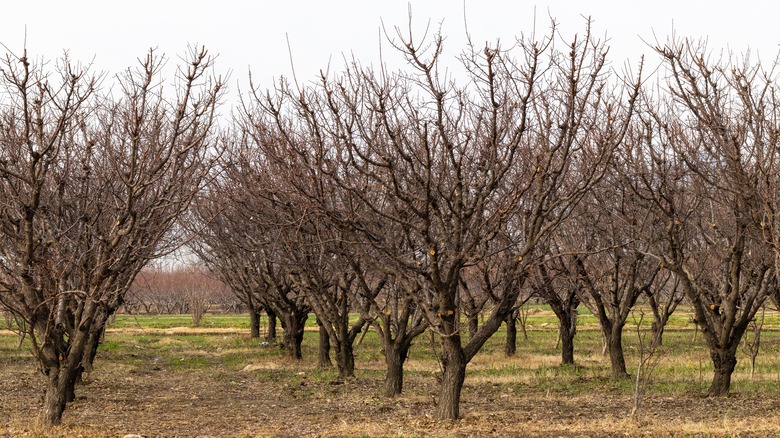The Not-So-Sweet Origins Of Georgia Peaches
The peach is an inescapable emblem of Georgia, emblazoned on t-shirts, mugs, "I voted" stickers, and highway billboards welcoming visitors to the state. It shows up on street signs and business names, in festivals and New Year's celebrations. Since the state's governor, E.D. Rivers signed legislation authorizing license plates to "advertise, popularize, and otherwise promote Georgia as 'The Peach State'" in 1939, politicians and residents have been passionately following his direction. In 1995, Georgia officially recognized the peach as its state fruit, and even though it's never been a particularly reliable part of the economy, its place in the state's mythology is as ironclad as ever.
Given the prevalence of peaches in the state, you might assume that the two entities have always been entwined. But the history of the peach and its journey to Georgia is a circuitous and often bitter one, winding its way through ancient Asia, Native American history, slavery, climate change, and ongoing labor disputes. Despite the pride that many Georgians feel for the fruit, you don't have to look back very far to discover that the history of the peach in the state is not so peachy after all.
Peaches took a long, meandering journey to Georgia
The earliest signs of peach cultivation date back to 5,000 or 6,000 B.C. on the banks of the Yangtze River in what is now Eastern China. Not surprisingly, the fruit was eagerly adopted by cultures far afield, most notably in Persia, where it was so widely cultivated that its botanical name Prunus persica, meaning "Persian plum."
When the Spanish conquistador Hernando de Soto arrived in North America in the early 1500s, he brought peaches with him. It was Florida, not Georgia, where the fruit first alighted, but it quickly spread north. It grew just as happily in Jamestown, Virginia in the 1600s as it did in St. Augustine, Florida in the 1500s. When it arrived in Georgia in the 1570s, it was just as amenable.
A few hundred years later, Georgians embraced this winding journey of the peach as if it were pre-ordained. In pageants across the state, young women portrayed the fruit, searching for their place in the world before finally arriving in Georgia, its one true home.
They were cultivated by Native Americans
The Spanish brought peaches to North America, but it was the Native Americans who cultivated the fruit. Indigenous tribes including the Muscogee, Iroquois, Lenape, and Cherokee planted trees around their villages and relied on them during fallow periods. An English naturalist observed that some of the peaches from the Lenape orchards grew to 13 inches in circumference, highlighting the mastery with which they approached cultivation. In modern agriculture, most farmers use grafted plants – ones made of a splice between a tree with good roots and one with good fruit – to ensure uniformity and predictability. Indigenous farmers grew their trees from seedlings, meaning just one tree. While this method can produce unpredictable results (similar to how a child may look completely different from either of its parents), it also has the potential to create unique genes. By growing their peaches from seedlings, Native Americans were able to select and cultivate superior trees over generations.
When the new American government turned to ethnic cleansing in the late 1700s to eradicate the indigenous population of the eastern United States, they went for the peach orchards, burning and chopping down thousands of trees to prevent people from returning. Less than a century later, the same tactic was used in the Southwest, where tribes including the Navajo had also cultivated abundant peach orchards for centuries. They, too, were burned to the ground, while the Navajo were forced to walk almost 400 miles in the winter to an internment camp.
Before the Civil War, peaches were seen as weeds
Aside from the carefully cultivated Native American orchards, peaches were widely regarded as a weed by colonists. Because they grew so easily and rapidly, the wild trees took over vast swaths of untended land, forcing settlers to clear them in order to use the area as farmland. In the late 17th and early 18th centuries, farmers complained of their invasiveness and the difficulty of clearing them from unclaimed land. Ironically, one of the probable reasons the fruit took hold so rapidly was because it was a particular favorite of wild hogs which, just like the peaches, had been haphazardly introduced to North America by Hernando de Soto.
Even in the lead-up to the Civil War, peaches were seen as a pesky invasive species. There were accounts of runaway slaves relying on them as food during their journey to freedom in the North, but to the rest of Georgia's population, they were only good for brandy and hog feed. Crops such as cotton, tobacco, and corn were the agricultural heart of the state.
They were meant to solve the cotton problem
In the wake of the Civil War, Georgia's agriculture went through a radical change. On top of the labor shortage created by the abolition of slavery, there was an agricultural crisis. Cotton had been such a valuable crop that plantation owners destroyed their own soil attempting to extract as much of it as possible. Monoculture, as it's known, is the practice of intensively farming a single crop in the same area. While this increases productivity and streamlines cultivation, it can also create an imbalance in the soil, sapping it of nutrients and rendering it infertile. With only one type of root to soak up water, it also creates more potential for run-off and erosion.
Due to generations of intensive cotton monoculture farming, the landscape in parts of Georgia was stripped bare and could no longer support the crop that had made its owners wealthy. Peaches offered a new avenue for the state's agricultural system. Not only were the trees kinder to the soil, but they offered a much-needed makeover for an industry that was steeped in the horrors of slavery.
Peaches helped maintain the cotton industry
Despite the cotton industry's post-Civil War crisis, this crop has always been the agricultural powerhouse of the state. From the days of slavery through the peach boom and up to the present, its economic footprint has overshadowed fruit production in Georgia, at least as far as the economics are concerned. In the 1910s, when the peach industry was booming, cotton farming was at its height, covering millions of acres and producing millions of bales each year. It suffered a setback during Reconstruction when plantation owners lost their free labor and the ground was depleted, but it came roaring back into prosperity by the end of the century. In 2022, the peach market in Georgia was valued at $34 million. The cotton market was worth $1.2 billion (via the USDA).
Georgia made a concerted effort to boost the profile of peaches over cotton, but not only did the fruit hold a subordinate position in economic value, it also helped King Cotton flourish. Laborers needed work year-round, and with cotton planting taking place in the spring and harvesting in the fall and winter, it couldn't provide a living. Peach farming dovetailed perfectly with these sluggish months, requiring harvesting and tree trimming in the summer. This symbiosis meant that laborers had the full-time employment they needed, keeping both industries humming along.
Peach farming was part of a wider trend
Peach growing in Georgia was part of a cultural shift away from the barbaric world of plantation-owning and toward the supposedly urbane world of horticulture. American elites in the North had already been embracing the lofty pursuit of gardening, like their English forebears, and around the time of the Civil War, wealthy landowners and small-scale farmers in the South began to follow suit. In Georgia, the transition was in large part facilitated by Belgian aristocrats, Prosper and Louis Berckmans, who turned a plot of Augusta land into a thriving orchard and garden in the 1850s. Fruitland Nurseries eventually had over 300 varieties of peaches, leading Prosper to be nicknamed "the Father of the Peach."
After the Civil War, small-scale farmers followed in the Berckmans' footsteps, planting their own orchards. Their advantage lay in the fact that Georgia's Southern climate produced the fruit earlier than Northern orchards. When peaches were shipped to New York and Boston, they were met by eager customers who had plenty of money to subsidize the burgeoning industry.
The peach industry offered Georgia a much-needed rebrand
It took very little convincing for Georgia to embrace a different kind of farming. Cotton, tobacco, and corn were inextricably linked to slavery, and the sophisticated world of fruit growing offered the state's agricultural sector a welcome makeover. Aside from peaches, farmers experimented with grapes, apples, and pears, but found that the fuzzy orange fruit fared better. Eventually, as horticulturalists developed genetically improved varieties, peaches became the focus of the state's new, sparkling image.
Festivals were organized to celebrate the fruit and were eventually attended by governors, congressmen, and visitors from all over the country. Aligning the peach with youthful female beauty was a stroke of marketing genius, allowing peach festivals to not only center on the fruit, but on beauty pageants as well. The Georgia Peach Festival in Fort Valley has been the main peach celebration in the state since it was created in the 1920s and revived in the 1980s, and features an annual "Miss Georgia Peach" pageant. The town was at the epicenter of the peach industry in the late 19th and early 20th centuries, and successfully lobbied to create a new county, Peach County, in 1924.
On the surface, Georgia had overhauled its image, transforming from a slave-driven plantation state to one that oozed southern charm and refinement. Just below the surface, however, the picture was less rosy.
Starting an orchard was out of reach for many farmers
Following the Civil War, the Reconstruction Amendments were passed to empower formerly enslaved people to take up new roles in society through land ownership, education, and enfranchisement. But white southerners pushed back, and when it came to the new craze of fruit cultivation, there were even greater barriers to entry for Black farmers. It takes years for a peach tree to produce fruit, and orchards took space that could be used for faster-growing crops. For many Black Georgians, such an endeavor was financially impossible.
Added to the economic barrier was the fact that growing fruit trees required specialty knowledge found only in books. Literacy was therefore a prerequisite to the industry, closing the door on an even greater number of prospective farmers. The insider knowledge added to the appeal for many wealthy landowners who wanted to distance themselves from the lowly connotations of Southern farming and align themselves with European sophistication.
There were eventually opportunities for Black farmers in the peach industry. Fort Valley State University in the heart of peach country was founded in 1895 by an interracial cohort, some of whom were formerly enslaved. Although its mission was wide-ranging, it focused on providing Black workers with the skills to prosper in the peach industry beyond the low-paying realm of menial labor.
The industry was built on exploited labor
Even though many Black Georgians could not afford to start orchards, they were the driving force behind the industry. As the peach market grew, Black laborers remained exploited, underpaid, and the targets of increasingly brutal racism. In the 1880s and '90s, the daily wage for a farm laborer was about 95 cents, according to contemporary data from the Journal of Political Economy, while a bushel of peaches was valued at $15 a bushel, the equivalent of nearly $500 today (per The Economist). One story from the period tells of a landowner who found three Black children with a handful of peaches from his orchard and demanded $7 per peach from their father, promising to send them to a chain gang if they ever returned.
At its height in the 1920s, the peach industry was producing 8 million bushels of fruit each year (per the New Georgia Encyclopedia) and was becoming the dominant symbol of the state. At the same time, however, Black workers were starting to leave their jobs in droves for higher-paying industrial jobs in cities with a lower threat of violence. The influential 1930 publication, "The Negro Wage Earner," compared the conditions of Black farm workers in the South in the early 20th century to slavery and pointed to a 1921 incident in which a plantation owner in Georgia murdered 11 of his farm hands. With a shrinking workforce, the industry began to decline in the 1930s.
It still preys on disempowered workers
When Black farm workers began leaving rural Georgia in search of better work and personal security in cities in the early 20th century, orchard owners were in desperate need of cheap labor to maintain their business. For a brief period, they took advantage of the state's lack of child labor laws and hired schoolchildren. Following the Second World War, they turned to a government program that provided temporary work permits for migrants from the Bahamas, Jamaica, and Barbados. By the latter half of the 20th century, they relied on labor through the H-2A guest-worker program. As of 2020, the state had 27,614 migrants in the state working under the program.
But more than 150 years after the abolition of slavery, the system is still fraught with exploitation. In 2021, a federal indictment revealed that the labor conditions at vegetable farms in southern Georgia amounted to modern-day slavery. A separate investigation led to similar conclusions on a blueberry farm in 2023. A lawyer representing the farm workers in the 2021 case revealed that such brutal conditions were a pervasive problem on Georgia farms, according to the Atlanta Journal-Constitution.
Peaches are a relatively small market for Georgia
Peaches hold a key status in Georgia's mythology, but they account for only a fraction of the state's agriculture. According to the USDA, in 2022, peaches were only the 14th most valuable crop in Georgia behind cotton, peanuts, cabbage, melons, and blueberries, to name a few. Five years before that, it ranked 17th.
Even when it comes to the market share of peaches, Georgia is behind other states. In 2022, it produced 25,000 tons, compared to South Carolina's 67,000 and California's 475,000 (per Statista). But even if it could outgrow its competitors, Georgia can't afford to rely on peaches. Although they are the emblem of the state, they are a notoriously fussy crop when it comes to mass production. They may have grown like weeds in the 18th century when few people were interested in them, but if you're trying to grow consistently high-quality fruit for a large market, they are tough to rely on. Late winter freezes can wipe out a whole season, while throughout the 20th century, brown rot, peach tree short life, and pests sent the market into turmoil. These days, many farmers have diversified their crops to ensure that the fruit isn't their only source of income. Peaches may not be at the heart of Georgia's economy, but that's probably a good thing as far as the state's agricultural economy is concerned.
The future of Georgia peaches looks bleak
After over a century of being the state's most famous fruit, the Georgia peach may be in jeopardy. Farmers are accustomed to fluctuations in the yearly haul, but fears are growing over the effects of climate change. In 2023, a projected 95% of the state's crop was destroyed due to an unseasonably warm winter combined with late freezes (per the Washington Post). The situation was so dire that the USDA declared 18 states to be natural disaster areas, while the monetary loss was projected to be near $200 million (via the New York Times). It's a particularly bad year for the Georgia peach market, but it may be less of an aberration than it seems.
The central valley that once offered the perfect climate for peach trees is changing. The fruit needs to be in temperatures below 45 degrees Fahrenheit for about 850 hours a year to ripen, with 1,000 being optimal. With warming winters, these critical cold periods are becoming shorter and less frequent. In 2017, one of the worst seasons in recent years, there were only 647, resulting in an 85% crop loss.
In 2020, the USDA introduced three new varieties of peaches, the Liberty Joy, Crimson Joy, and Rich Joy, all of which were engineered to require fewer chill hours. These may sustain the Georgia peach market in the short term, but with climate change causing warmer winters and later freezes, it may just be kicking the can down the road.
